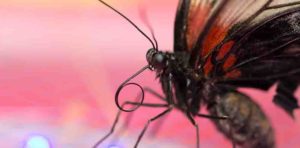
Butterflies and moths, the Lepidoptera, are among the most beautiful of insects, familiar to almost everyone through thousands of different species from all around the world. But how they evolved has been something of a mystery to scientists because of a surprising lack of Lepidoptera fossils.
Now researchers in the Netherlands have discovered Lepidoptera fossils that are older than any previously found, proving these familiar insects have been around for at least 200m years. The particular type of fossils found mean we have to rethink Lepidoptera evolution. They imply that the long tube butterflies and moths use to suck nectar from flowers actually developed before flowering plants did, so it must have originally evolved for a different purpose.
The fossil record of ancient Lepidoptera is surprisingly meagre. Although butterflies may appear to be delicate creatures, their external skeletons are made of the same tough material, chitin, that all insects are made of. And chitin, or chitin decay products, preserve really very well in the fossil record.
In fact, some of the best ever fossils are of insects entombed in amber. Fossil Lepidoptera have been reported from a few exceptional deposits. For example, butterflies are known from the famous Florissant fossil beds of North America dating from the Eocene epoch, 34 million-years-old. A fossil caterpillar with the characteristic spinneret (the body part that produces silk) typical of all modern butterflies and moths has been reported from 125 million-year-old Lebanese amber. But until now, the fossil record went back no further.
This is especially odd because the Lepidoptera are closely related to another familiar modern group of insects, the caddis flies or Trichoptera. This group has an excellent fossil record extending back to the Permian period of the Palaeozoic era (250m years ago). As these groups share a common ancestor, the earliest Lepidoptera should, theoretically, also be found in the Permian period.
Lucky accident
The newly discovered fossils aren’t quite that old but they do date to the end of the Triassic period, the beginning of the age of dinosaurs. The delicate fossils bear the highly characteristic scales of butterflies and moths. They were discovered entirely by accident when researchers tried to extract pollen grains from rock samples from a borehole in north Germany to date the strata.
The process dissolves the rock (usually with the incredibly powerful hydrofluoric acid) to leave behind an organic residue that is rich in tough organic material. While this is usually pollen material and other so-called phytodebris from plants, it can include the remains of sclerotised (toughened) exoskeleton from insects and other invertebrates. Bits of fossil scorpions can be found this way for example.
Not many insects have scales on their wings, and those found on the wings of butterflies and moths are very different from those of other insects that do possess them. A characteristic feature of lepidopteran scales is a herring bone (V-shaped) pattern of fine lines in between larger ridges that extend along the scale. There are also characteristic outlines and margins that distinguish butterfly scales. So there is no doubt that the fossil scales found in the German borehole are those of ancient butterflies and moths.
Just as interesting, the scales are from a group of butterflies and moths known as the Glossata. Almost all of todays’ butterflies and moths belong to this group, characterised by the tube-shaped mouth part known as a “proboscis” used for feeding on fluids such as nectar. There are some primitive moths with mandibular (biting) mouth parts, and indeed some examples of these have been found from the Early Jurassic epoch (around 190 million-years-old). But the latest discoveries are even older, and push the origin of modern butterflies with proboscises back another 70 million years.
This forces a serious rethink for evolutionary biologists. Until now we’ve thought that the highly modified sucking mouthparts of modern butterflies and moths evolved as flowering plants diversified in the Early Cretaceous, around 100m years after the newly discovered fossils were created.
The researchers who discovered the fossils suggest that Lepidoptera may have first evolved their long proboscis tubes to suck up any available liquids at a time when their environment had become a lot drier. We know this kind of climate change did happen on the super continent of Pangaea in Triassic times, but it’s probably too early to tell if this theory is correct. If the fossil record can be pushed back 70m years in one stroke, it may get pushed back even further, and we’d need another way to explain the change.
Whatever the trigger for the development of the butterfly proboscis, it was clearly an evolutionary innovation that resulted in phenomenal diversity and added immensely to the beauty of planet Earth. Let us hope that many more of these serendipitous discoveries can shed even more light on the wonderful story of biological evolution. The key is in looking for fossils.
Note: The above post is reprinted from materials provided by David Martill, Professor of Palaeobiology, University of Portsmouth
This article was originally published on The Conversation. Read the original article.










